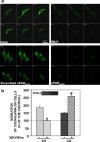The cross-talk between the urokinase receptor and fMLP receptors regulates the activity of the CXCR4 chemokine receptor
- PMID: 20972812
- PMCID: PMC11114667
- DOI: 10.1007/s00018-010-0564-7
The cross-talk between the urokinase receptor and fMLP receptors regulates the activity of the CXCR4 chemokine receptor
Abstract
The receptor (CXCR4) for the stromal-derived factor-1 (SDF1) and the urokinase-receptor (uPAR) are up-regulated in various tumors. We show that CXCR4-transfected cells migrate toward SDF1 on collagen (CG) and do not on vitronectin (VN). Co-expression of cell-surface uPAR, which is a VN receptor, impairs SDF1-induced migration on CG and allows migration on VN. Blocking fMLP receptors (fMLP-R), alpha-v integrins or the uPAR region capable to interact with fMLP-Rs, impairs migration of uPAR/CXCR4-transfected cells on VN and restores their migration on CG. uPAR co-expression also reduces the adherence of CXCR4-expressing cells to various components of the extracellular matrix (ECM) and influences the partitioning of beta1 and alpha-v integrins to membrane lipid-rafts, affecting ECM-dependent signaling. uPAR interference in CXCR4 activity has been confirmed in cells from prostate carcinoma. Our results demonstrate that uPAR expression regulates the adhesive and migratory ability of CXCR4-expressing cells through a mechanism involving fMLP receptors and alpha-v integrins.
Figures










Similar articles
-
Urokinase receptor and CXCR4 are regulated by common microRNAs in leukaemia cells.J Cell Mol Med. 2015 Sep;19(9):2262-72. doi: 10.1111/jcmm.12617. Epub 2015 Jun 16. J Cell Mol Med. 2015. PMID: 26082201 Free PMC article.
-
The urokinase receptor takes control of cell migration by recruiting integrins and FPR1 on the cell surface.PLoS One. 2014 Jan 21;9(1):e86352. doi: 10.1371/journal.pone.0086352. eCollection 2014. PLoS One. 2014. PMID: 24466048 Free PMC article.
-
uPAR regulates pericellular proteolysis through a mechanism involving integrins and fMLF-receptors.Thromb Haemost. 2013 Feb;109(2):309-18. doi: 10.1160/TH12-08-0546. Epub 2012 Dec 13. Thromb Haemost. 2013. PMID: 23238745
-
Protease crosstalk with integrins: the urokinase receptor paradigm.Thromb Haemost. 2001 Jul;86(1):124-9. Thromb Haemost. 2001. PMID: 11486997 Review.
-
Multiple activities of a multifaceted receptor: roles of cleaved and soluble uPAR.Front Biosci (Landmark Ed). 2009 Jan 1;14(7):2494-503. doi: 10.2741/3392. Front Biosci (Landmark Ed). 2009. PMID: 19273214 Review.
Cited by
-
Cyclization of the urokinase receptor-derived ser-arg-ser-arg-tyr Peptide generates a potent inhibitor of trans-endothelial migration of monocytes.PLoS One. 2015 May 4;10(5):e0126172. doi: 10.1371/journal.pone.0126172. eCollection 2015. PLoS One. 2015. PMID: 25938482 Free PMC article.
-
Urokinase receptor and CXCR4 are regulated by common microRNAs in leukaemia cells.J Cell Mol Med. 2015 Sep;19(9):2262-72. doi: 10.1111/jcmm.12617. Epub 2015 Jun 16. J Cell Mol Med. 2015. PMID: 26082201 Free PMC article.
-
Urokinase type plasminogen activator receptor (uPAR) as a new therapeutic target in cancer.Transl Med UniSa. 2016 Nov 1;15:15-21. eCollection 2016 Nov. Transl Med UniSa. 2016. PMID: 27896223 Free PMC article.
-
CRISPR/Cas9 uPAR Gene Knockout Results in Tumor Growth Inhibition, EGFR Downregulation and Induction of Stemness Markers in Melanoma and Colon Carcinoma Cell Lines.Front Oncol. 2021 May 14;11:663225. doi: 10.3389/fonc.2021.663225. eCollection 2021. Front Oncol. 2021. PMID: 34055629 Free PMC article.
-
N-Formyl Peptide Receptors Induce Radical Oxygen Production in Fibroblasts Derived From Systemic Sclerosis by Interacting With a Cleaved Form of Urokinase Receptor.Front Immunol. 2018 Apr 4;9:574. doi: 10.3389/fimmu.2018.00574. eCollection 2018. Front Immunol. 2018. PMID: 29670612 Free PMC article.
References
-
- Kucia M, Reca R, Miekus K, Wanzeck J, Wojakowski W, Janowska-Wieczorek A, Ratajczak J, Ratajczak MZ. Trafficking of normal stem cells and metastasis of cancer stem cells involve similar mechanisms: pivotal role of the SDF-1-CXCR4 axis. Stem Cells. 2005;23:879–894. doi: 10.1634/stemcells.2004-0342. - DOI - PubMed
Publication types
MeSH terms
Substances
LinkOut - more resources
Full Text Sources
Miscellaneous

